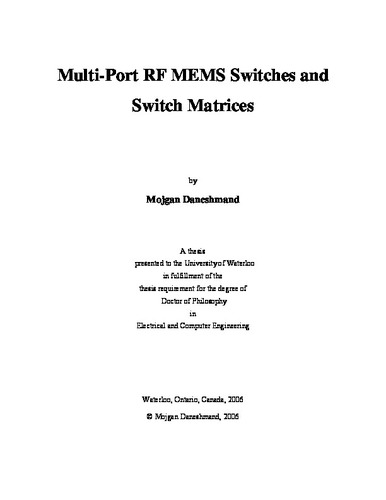| dc.contributor.author | Daneshmand, Mojgan | en |
| dc.date.accessioned | 2006-08-22 14:00:54 (GMT) | |
| dc.date.available | 2006-08-22 14:00:54 (GMT) | |
| dc.date.issued | 2006 | en |
| dc.date.submitted | 2006 | en |
| dc.identifier.uri | http://hdl.handle.net/10012/878 | |
| dc.description.abstract | Microwave and millimeter wave switch matrices are essential components in telecommunication systems. These matrices enhance satellite capacity by providing full and flexible interconnectivity between the received and transmitted signals and facilitate optimum utilization of system bandwidth. Waveguide and semiconductor technology are two prominent candidates for the realizing such types of switch matrices. Waveguide switches are dominant in high frequency applications of 100 ? 200 GHz and in high power satellite communication. However, their heavy and bulky profile reinforces the need for a replacement. In some applications, semiconductor switches are an alternative to mechanical waveguide switches and utilize PIN diodes to create the ON and OFF states. Although, these switches are small in size, they exhibit poor RF performance and low power handling. <br /><br /> RF MEMS technology is a good candidate to replace the conventional switches and to realize an entire switch matrix. This technology has a great potential to offer superior RF performance with miniaturized dimensions. Because of the advantages of MEMS technology numerous research studies have been devoted to develop RF MEMS switches. However, they are mostly concentrated on Single-Pole Single-Throw (SPST) configurations and very limited work has been performed on MEMS multi-port switches and switch matrices. Here, this research has been dedicated on developing multi-port RF MEMS switches and amenable interconnect networks for switch matrix applications. To explore the topic, three tasks are considered: planar (2D) multi-port RF MEMS switches, 3D multi-port RF MEMS switches, and RF MEMS switch matrix integration. <br /><br /> One key objective of this thesis is to investigate novel configurations for planar multi-port (SPNT), C-type, and R-type switches. Such switches represent the basic building blocks of switch matrices operating at microwave frequencies. An in house monolithic fabrication process dedicated to electrostatic multi-port RF MEMS switches is developed and fine tuned. The measurement results exhibit an excellent RF performance verifying the concept. Also, thermally actuated multi-port switches for satellite applications are designed and analyzed. The switch performance at room condition as well as at a very low temperature of 77K degrees (to resemble the harsh environment of satellite applications) is measured and discussed in detail. <br /><br /> For the first time, a new category of 3D RF MEMS switches is introduced to the MEMS community. These switches are not only extremely useful for high power applications but also have a great potential for high frequencies and millimetre-waves. The concept is based on the integration of vertically actuated MEMS actuators inside 3D transmission lines such as waveguides and coaxial lines. An SPST and C-type switches based on the integration of rotary thermal and electrostatic actuators are designed and realized. The concept is verified for the frequencies up to 30GHz with measured results. A high power test analysis and measurement data indicates no major change in performance as high as 13W. <br /><br /> The monolithic integration of the RF MEMS switch matrix involves the design and optimization of a unique interconnect network which is amenable to the MEMS fabrication process. While the switches and interconnect lines are fabricated on the front side, taking advantage of the back side patterning provides a high isolation for cross over junctions. Two different techniques are adopted to optimize the interconnect network. They are based on vertical three-via interconnects and electromagnetically coupled junctions. The data illustrates that for a return loss of less than -20dB up to 30GHz, an isolation of better than 40dB is obtained. This technique not only eliminates the need for expensive multilayer manufacturing process such as Low Temperature Co-fired Ceramics (LTCC) but also provides a unique approach to fabricate the entire switch matrix monolithically. | en |
| dc.format | application/pdf | en |
| dc.format.extent | 8058916 bytes | |
| dc.format.mimetype | application/pdf | |
| dc.language.iso | en | en |
| dc.publisher | University of Waterloo | en |
| dc.rights | Copyright: 2006,
Daneshmand, Mojgan. All rights reserved. | en |
| dc.subject | Electrical & Computer Engineering | en |
| dc.subject | RF MEMS Switches | en |
| dc.subject | switch matrices | en |
| dc.title | Multi-Port RF MEMS Switches and Switch Matrices | en |
| dc.type | Doctoral Thesis | en |
| dc.pending | false | en |
| uws-etd.degree.department | Electrical and Computer Engineering | en |
| uws-etd.degree | Doctor of Philosophy | en |
| uws.typeOfResource | Text | en |
| uws.peerReviewStatus | Unreviewed | en |
| uws.scholarLevel | Graduate | en |

